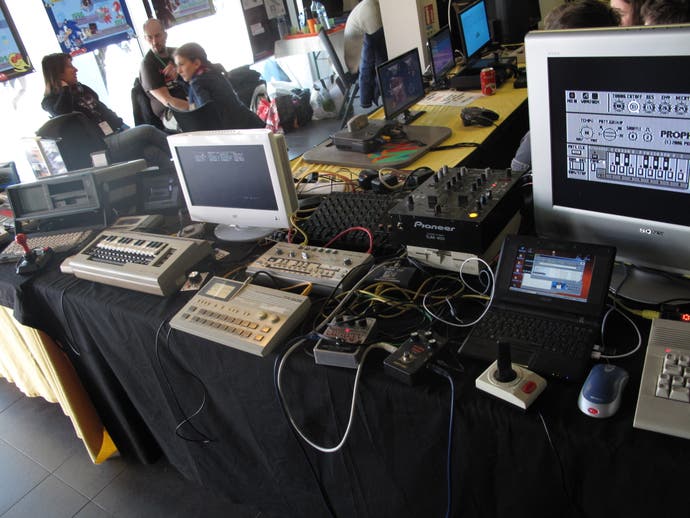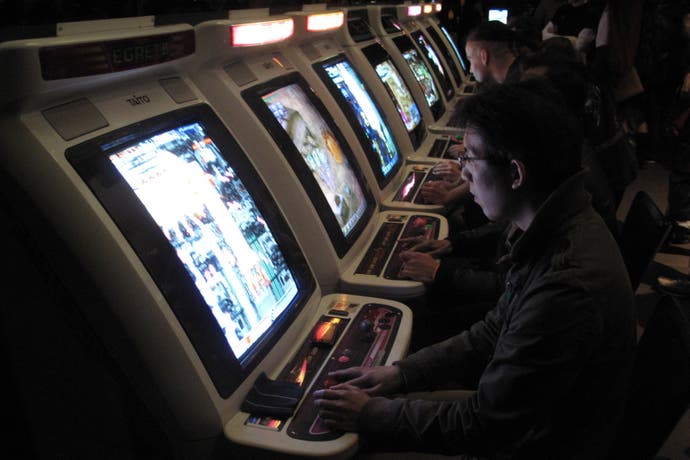Taking arcades out of the underground
A report from the France's Stunfest, an open-armed event that embraces gaming's more hard-edged communities.
Arcade culture has, for years, occupied a strange position in the global gaming community's hive mind.
Infamous as a place of ultimate dedication to the medium of games, the likes of fighters and shmups are renowned for demanding near-superhuman skill levels at a competitive level. The related collectors' market, meanwhile, and the apparent depth of pockets of those involved, only serves to further the idea that arcades are something of a fringe pursuit.
Meanwhile, the once roaring flames of the arcade industry have lapped back to an ember, meaning a fraction of the world's game playing public regularly, if ever, stand at a cabinet, the ball-top of a stick in their fingers.
And so it is that arcade gaming is today niche. But it hasn't always been. The first wave of commercial gaming was a casual one, born in arcades. Long before mobile gaming and Wii Sports, families and the inexperienced were flocking to rooms bathed in the light of giants of the golden era of arcades.
It's a fact worth remembering if you ever visit Stunfest, the French celebration of all things arcade - and much more besides - that in early May celebrated its 10th anniversary event.

Stunfest unquestionably has underground arcade gaming as its beating heart. A decade ago the gathering debuted in an underground car-park, bringing together beat 'em-up players for a tournament in the city of Rennes, where it still takes place. Literally and metaphorically, Stunfest has underground roots.
Today, that heritage persists. This year's Stunfest, at a vast venue in the middle of Rennes, centred around two arenas. One was filled with countless players locking horns to climb through the ranks of the various Stunfest fighter tournaments; the other contained rows of cabs and superguns for the public, as well as hundreds of seats and two stages so as the world's most skilled players could showcase their talents.
To the delight of the roaring crowds and some commendably animated commentators, prominent fighter players like Justin Wong, Ryan Hart, Momochi and Luffy showcased captivating skills across a wealth of different titles, with numerous matches played out to the audience.
And for the visiting shmup devotees, Stunfest stood out as an event that gave 2D shooters a remarkably high profile, only a little way behind fighters. A clique of Japan's best players attended the event, with DoDonPachi world record holder SOF-WTN, the globe's best Ketsui expert SPN and Ikaruga double-player Hattori enjoying time on the main stage. And, yes, double-play is the art of a single player demolishing a shmups's two-player mode, a stick on each hand, fingers stretched across both sets of buttons like a piano maestro. There were even a number of European players in attendance that took to the stage to demonstrate outstanding 2D shooter talent.
More on all those performances later, because it would do the event an injustice to skip past its other significant feature; in a maze of wide, open corridors and mezzanines circling Stunfest's hardcore centre, offering much else besides shooters and fighters. Countless dedicated-cab arcade games filled every nook and cranny - those with sit-down jetskis, lightguns, pedals, wheels and sniper rifles. Turn a corner and you might find a stall providing a console modding service or excited crowds surrounding a Beatmania demo.
"It isn't a commercial event, and it's about the people and friends and people that share games. It's not about the newest games; it's about what we love."

There were more common games too; it seemed that everywhere an improvised Mario Kart, Bomberman or GoldenEye 64 clash was just beginning. Rows of tables offered visitors the chance to try their hand at NeoGeo, MSX2, Amiga and Vectrex releases, or the opportunity to see a sprawling chiptuner rig, realised in tangled cables, synths and adapted consoles. There was even an indie showcase and a conference room with sessions for the public, that late at night transformed into a rave venue, shaken by game music bass while demonstrating that those that play games can sometimes throw shapes.
"What Stunfest is today came about naturally over the years," explains head coordinator and beat 'em-up player Aymeric Lesne. "It was a fighting tournament first, and then an arcade event, and then we kept welcoming more people. You like rhythm games? Come join us. You create indie games? Please join us. That is how it happened. First it was our friends, and they brought new things. That is the spirit of Stunfest, and it still is. It isn't a commercial event, and it's about the people and friends and people that share games. It's not about the newest games; it's about what we love.
" But in spite of all that, Stunfest is undoubtedly a core arcade event; see that heritage that goes back to the underground car park, and consider that it is run by a band of fighter players. Yet it is also a gathering doing all it can to break down the barriers that currently separate mainstream gaming from arcade culture. For all that makes it wonderful, arcade culture has in recent years arguably retreated into a cabinet-stuffed ivory tower; hardly the best strategy for a scene foundered on a now floundering industry.
But at Stunfest, perhaps in part thanks to the presence of console and other forms of gaming, there are families and youngsters everywhere. And most found their way to the event's arcade heart. This was a truly democratic gathering, and it wasn't hard to spot a father and young daughter sat at a cab, playfully sharing one of Cave's infamously testing shmups, while a world record holder from overseas, rather than lurk backstage, sat at a neighbouring cabinet demonstrating top-level skills to a crowd of strategy-hungry arcade aficionados.
And it's clearly something that those from Japan - the arcade industry's most important bastion - have noticed too. "This is an extremely friendly event, and everybody has welcomed us," offers the unfathomably skilled player SOF-WTN, taking a break from time on stage proving that shmups can fire up a crowd as much as any fighter. "That has felt good. It has helped getting rid of a lot of the nerves before coming to the event. It's reassured me, and that happened when I've been talking with people and walking around the event."

"Compared to other events in Japan this has a very different atmosphere, For instance, at Stunfest you see lots of adults bringing their children. I even saw a group of schoolchildren walking around. It feels very open here, where as in Japan the idea of games is quite different; the positioning of games in the public eye is very different. I really think the openness here at Stunfest is great.
" But in spite of the festival atmosphere, and the fact that seeing young players queue to play at a cab gives much reason to be hopeful about the future of arcade games, Stunfest was an event not just for, but about players.
In a global games industry obsessively focused on companies, their most famed staff and the products they create and sell, the player is often forgotten, marginalised to little more than audience, reader and customer. In arcades, it has always been different. Players are the focal point, and at Stunfest, that was absolutely the case. Certainly, there were odd sponsors to fund flying over players from around the world, but to call the gathering commercial would rather misrepresent the reality. And most players destined for Stunfest's stage covered their own expenses. Indeed, a huge chunk of the thousands in attendance had contributed to Stunfest in some way, loaning cabs and games, helping organise, and happily picking up even the most mundane tasks over the three-main days of the event.
More than anything else, Stunfest 2014 was a chance to see the best players, and celebrate the people that played the games over those that made them. Watching the European shmup players on stage was a particular highlight, in that it reminded all in attendance that arcade gaming is absolutely a global culture. Of course, Japan remains home of most of the best shooter players, but names hailing from Europe like Plasmo, .SM, Icarus, Eaglet and DEL thrilled the crowd from the event's stages - and those taking in the Stunfest streams all over the world. Indeed, DEL even managed a tough to verify but presumed world record in the insanely challenging ver.1.01 Manpuku mode of Cave's shmup Muchi Muchi Pork (225-million-plus, and the 2-4 boss, if you think you have it in you to take it on). The attention on these European players - and their fighting game contemporaries -only served to reinforce Stunfest's status as the players' event.
The organisers hope that, with a little effort, they can spread that culture. "It's hard to explain, but we hope to encourage transmission of the passion," explains Lesne. "We hope that parents will bring their children and share with them the arcade games from their past. And from the other side, we hope maybe children that play video games will bring their parents and show them what that is. We hope we can help with the future generation of players."
Now though, the doors have closed, and Stunfest's 10th iteration is but a memory. Lesne's concept of transmission will no doubt continue, as Stunfest fuels yet more enthusiasm for arcade culture, and reminds many that it isn't as underground and inaccessible - or distant from mainstream gaming - as some like to imagine. Stunfest organising body 3 Hit Combo will now turn its attention to its other projects, using arcade and related culture to reach out to more of Rennes' citizens, and those far beyond France.
"I did what I did. I have no regrets."
Hattori

Each player that visited this year will leave with different highlights, but many will share one of the most staggering demonstrations of skill; player Hattori's double-play run of Treasure's iconic genre ambassador Ikaruga. It showed that a lone human can not just survive a single-credit run of the two-player game from beginning to end, but do so with control, flair, and while milking almost every drop from Ikargu's scoring system.
As for how Hattori felt it went?
"I did what I did. I have no regrets," he says, not even cracking a smile as he plays on Ikaruga's near-spiritual perspective on success and failure.
And then, he spring's into a unexpected diversion, revealing his passion for a certain puzzle arcade game.
"I also found time to play Puyo Puyo upstairs, and to a certain extent that game can become a very extreme competition with other players. But the best part was showing that to a new audience that isn't necessarily familiar with Puyo Puyo. There were lots of people that came and lots of people that watched, and I could really feel through those demonstrations of Puyo Puyo the love and appeal of that game growing." Hattori, like everyone else there, had absolutely thrown himself into the spirit of Stunfest. This was an event about sharing arcade gaming; freeing it from the underground niche, whatever the genre.

